Self-Inventions: The Photography of Suzy Lake
The portrait in classical photography performs a tightrope act, balancing between encompassing an ineffable essence and capturing the irreducible contingency of a moment in time. In Irving Penn’s Colette, Paris, 1951, for instance, Colette leans back, powdered face tilted into the light, eyes thick with mascara, bleeding back into the shadows. A blanket is pulled to her chest, her clothes old and luxurious, her left arm thrust up to her chin, giving her an air of immediacy and command. In Richard Avedon’s great 1957 portrait of Marilyn Monroe, her dark, glittering, sequined dress plunges between her breasts, and her face, gazing away from the camera, is startled, anxious and melancholy—heartbreakingly vulnerable.
Elaborately posed and lit, and no doubt selected from endless contact sheets—sessions with Avedon were famously long and emotionally draining—Penn’s and Avedon’s gorgeous portraiture is intensively formal, every wash of pale light, every stripe of shadow carefully controlled, yet at the same time theatrical. Unlike the subjects of stolid portraits fashioned in the 19th century, or for that matter in the 20th by lesser photographers, their women are anything but still; instead, they seem either to be caught in the act of creating themselves or completely unravelling.

Suzy Lake, ImPositions #1, 1977, 4 silver gelatin prints from stretched negatives, varied sizes approximately 140 x 276.5 cm. Collection Canada Council Art Bank. Courtesy the artist.
The essentialist notion of human identity or selfhood is about as absurd as the idea that we are purely constructed out of social 2011and historical circumstances or through some act of radical will; both take for granted a centredness, certainty and finality our selves never ultimately possess. We are, of course, constantly and arduously attempting and failing to invent ourselves against the surging fatality of history, circumstance and biology. It is this nexus that photographers like Penn and Avedon and, for that matter, Diane Arbus are so adept at capturing.
In Suzy Lake’s “On Stage,” 1972-1975, which is included as part of “Suzy Lake: Political Poetics” organized by Matt Brower and Carla Garnet for the University of Toronto Art Centre (the exhibit will travel to the McIntosh Gallery at the University of Western Ontario, the Macdonald Stewart Art Centre at the University of Guelph, the Mount Saint Vincent University Art Gallery in Halifax, and the Art Gallery of Peterborough), the task of fashioning personae, of performing versions of a self, is made literal in ways that are subtle and, occasionally, poignant. “Role playing,” Lake’s text accompanying one of the images reads, “is a daily occurrence; it can be as subtle as dressing for a special occasion, diplomacy, or inadvertently picking up someone’s mannerisms.” And in another, “Where do we begin to define our true selves? Our self image(s) is distorted by the moment’s mood, environment, and recent history, which is then balanced and/or reinforced by a particular life history of (biased) selective and accumulative growth.”
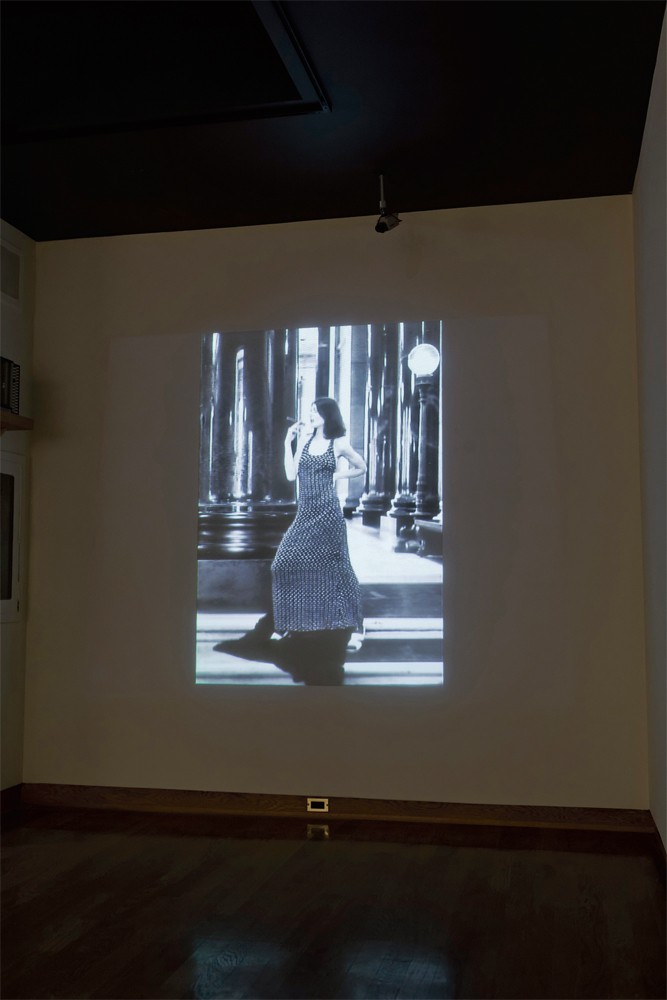
On Stage, originated as slide show 1972-1974; re-mounted as DVD in 2006; DVD loop. Courtesy Paul Petro Contemporary Art. Photographs: Toni Hafkensheid.
The images in “On Stage” are shot in a direct, black-and-white style so that they have an ironic, mock-documentary feel. In one, Lake saunters down a street in Montreal donning a curly wig and a beret, a hip young student on her way to a lecture. In another, she is shot close up, face darkly glittering with makeup. Her lips pouting, her eyeliner thick, her eyes nearly rolling back in her head, she could be one of the tragic junky glamour queens haunting Warhol’s Factory or the back room in Max’s Kansas City. She wears a long, sleek, sexy dress and puffs on a cigar as she frolics among the black marble pillars of what might be the lobby of a bank or corporation, a cover girl advertising the congruence of sex, money and power; she wears a backless dress and floppy wide-brimmed hat, stretched out on the floor as though on the deck of a yacht in the Baie des Anges; her face seems to be darkening, mouth pulled down, eyes brimming with tears, as though her temporary role were literally about to dissolve. And in yet another photograph, she sits at a kitchen table deep in the frame, her face a mask of white cream, tense, anxious, obviously incomplete.
Roles are things we inevitably take on, Lake points out, shaped by mood and environment, fantasy and desire. “On Stage” is of course partly about the way society imposes images—and self-images—on women, and in that sense it is a feminist work, but it is also about the fumbling pathos of finding an image for one’s self, an image that might have some hope of sticking to the slippery and porous prima materia from which we are made. Whereas Cindy Sherman’s iconic “Untitled Film Stills” of 1979 (a work undoubtedly influenced by Lake’s series of just a few years earlier) have a seamless elegance—one has to do a double take to realize that it is Sherman in a blonde wig in the photos and not a B-grade bombshell in a 1950s Hollywood film—the jagged theatricality of Lake’s portraits in “On Stage” is front and centre. Lake is more interested in process and revision, the way roles are inhabited by living bodies, than in maintaining anything like illusion; she is more interested in the moment the illusion is imperfectly adopted, and when it breaks down. In other works from the same period, A Genuine Simulation of…, 1973-1974, 90 colour photographs arranged as a storyboard, one finds Lake at a table with a checkered table cloth smearing a mask of white cream onto her face, then taking it off, and the 10 black-and-white photographs in Suzy Lake as Andrea Stannard, 1974, present Lake as various versions of Stannard, some of them with the eyes, nose and lips scratched out with pencil. Born in Detroit, Michigan, in 1947, Lake studied fine art at Detroit’s Wayne State University, focusing on painting. The Detroit of the 1960s was politically and racially tumultuous—the riots and fires that gutted its black neighborhoods in 1967 were the ugliest and most tragic in the United States—and she was politically engaged from early on. “My father had a roofing and sheet metal shop in the city,” Lake told me. “It was a segregated neighborhood, but I remember my grandfather being helpful to neighbours. I was aware of inequality and racism as a child, so when I was old enough to act, I joined solidarity groups.” While a student at Wayne State, Lake was, as she says, “one of those kids who made the movement stronger.” Among her many activities, she volunteered for Detroit Mothers at the infamous Jeffrey’s Project where she helped single mothers by looking after their kids for a few hours during the day.
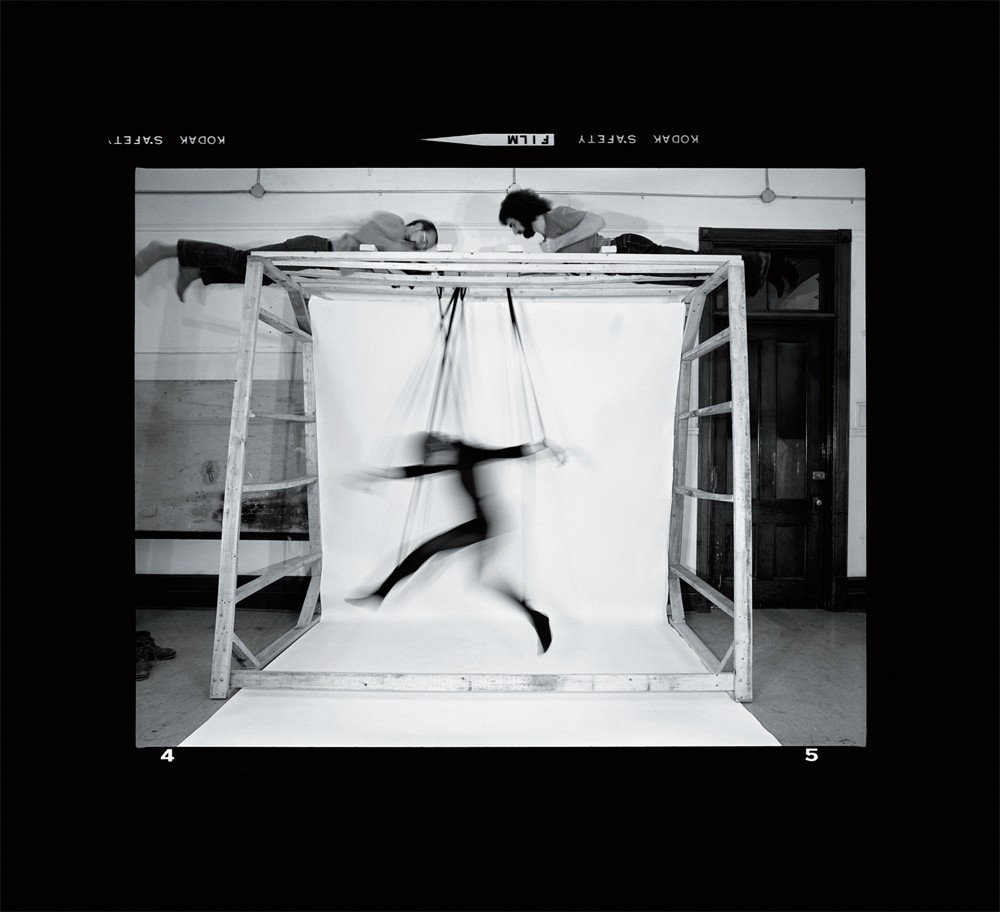
Choreographed Puppet #4-5, 1976 (2007 reprint), chromogenic print, 41 1/2”. Photograph: Suzy Lake. courtesy Paul Petro Contemporary Art.
By 1967, however, the political situation in Detroit had deteriorated beyond repair. “I knew I had to leave Detroit,” she told me. “The riots happened in my neighbourhood, it had become the centre of everything that was happening, and I was told I couldn’t be involved anymore. I checked out New York, and at one point I thought I would move to Boston, but because of the Vietnam War my painter boyfriend and I ended up moving to Canada—we emigrated to Quebec. Under the Napoleonic Code, I was technically his property!” “I had always struggled with how to deal with the relationship between my classical training and my work as an activist on the street,” Lake continued. “The first time I ever saw reductive minimalism was after I arrived in Montreal, and that was a similar struggle between form and content, which struck me as an interesting confluence. I started taking perceptual issues and performing them in order to understand them better. In those years Guido Molinari was a wonderful mentor. “I don’t know why you’re doing what you’re doing,” he once told me, “but I do know it’s yours!” While photographic sequences like “On Stage” always refer back to the body, and by implication, gender, Lake’s work beginning in the mid-1970s became more directly oriented toward performance and the body and at the same time engaged with formal issues familiar from the early minimalist work of figures like Bruce Nauman and Robert Morris. In the “Choreographed Puppets” series from 1976, for instance, she is suspended by straps from a crude, wood-framed puppet theatre, her movements manipulated by two puppeteers (one of them the artist Bill Viola) stretched out on top. Dressed in dancer’s tights, she jerks, thrashes, swings and dances, arms and legs constantly akimbo. Set against a white background, in “Choreographed Puppets” Lake is mostly a dark blur with a swooshing head of bobbed black hair, a tracery of motion that scarcely seems controllable by the straps or containable by the hastily nailed-up frame. “Choreographed Puppets” is about control and resistance, gravity and momentum and friction; it is also, as she told me, about “the controlling hand of the other.” “ImPositions,” 1977, on the other hand, is about confinement. Printed on stretched black-and-white negatives and stacked vertically, “ImPositions” consists of images of Lake bound and struggling in a narrow passage between lockers in a starkly lit, enclosed space. Arms, legs and hands tied, Lake pulls and twists against the restraints, the warping of the images making it look as though the walls are breathing, closing in. If “ImPositions” is an overtly political work about repression in its most blunt form, other works from the same period interlace the politically allusive with the aesthetic. In Choreographies of the Dotted Line, 1976, a video camera documents Lake unravelling herself from a huge roll of canvas, tracing the course of a single dotted line. The video records her heavy, rhythmic breathing as she rolls and rocks back and forth on the floor, and its close, intimate, rasping sound, especially when heard from an adjacent gallery, is hard not to read sexually. Vertical Pull, 1977, consists of 12 black-and-white photographs arranged in three sequences of four images of Lake rolling sidelong down a steep, dark stairway. Railings visible in perspective at the top of each image, the stairs flatten out into a series of black bars with bright horizontal streaks of light. Lake’s image is clearly readable in the centre sequence; in the right-hand one she is a translucent blur. Vertical Pull is among Lake’s most beautiful works of the mid-1970s with its cool, hard, noir sheen, but its metaphors are also simple and resonant. It is about the inexorable downward pull of the body, about the body not as a commodity in the eyes of another but as something in space and time.
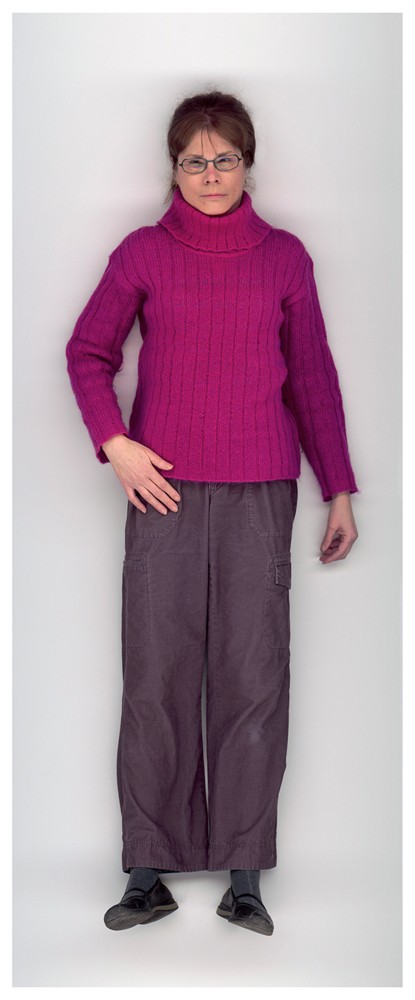
Reduced Performing: Blinking and Breathing #1, 2008, chromogenic print, 80 x 32.” Photograph: Suzy Lake. Courtesy Galerie Donald Browne, Montreal.
“I didn’t study photography in university; I didn’t even take a class, I studied painting,” Lake told me, “but photography has offered me the challenge of making photographs that function in durational terms. I couldn’t make a painting now—people wouldn’t get involved in a painting. I’ve made a lot of single images, but sequencing and time come back to haunt me a lot.” Although Lake has made videos of performances, like Choreographies of the Dotted Line and Box Concert, 1978, her work has never been fully time based; duration manifests itself in her art as a process of transformation. And “time” or “duration” in this sense is both deeply interior and not necessarily linear. The sequence in the black-and-white photo collage One Hour (Zero) Conversation with Allan B., 1973, for instance, has Lake, face painted white, hair neatly pulled back in a ponytail, in various phases and moods of a conversation, now animated, now reflective, with an unseen interlocutor; some of the images are circled with pencil, as though in them she was making some important point we as viewers are not party to. In Against the Wall, 1977, Lake stands, arms and legs bound, reeling sideways against a chipped and battered wall; the ghostly, dematerialized tracer of her body suggests that she is moving through an alternate dimension of time. The four high-keyed colour photographs in Dance to Life: Smashed Vase Sequence, 1986, begins with a blue vase full of white carnations, lilies, a spray against an equally deep Mediterranean blue background. Then a hammer appears in the frame swinging toward the vase, and in the third image, the vase shatters, spattering water and flowers and beautiful blue shards. The final image in the series could be a detail from a gestural abstraction, all glistening droplets, pulverized glass and swimming light arcing downward.
Suzy Lake is typically regarded as a feminist artist whose work addresses issues of gender, identity and the body, and that is true enough, but her art, even at its most raw, has never been didactic and has always taken pictorial issues seriously. “Back in the 1970s, I was extremely active supporting women politically, but I didn’t identify with a lot of the work since it was more conceptual than mine,” she told me. “I like getting my hands dirty as though I were still a painter. I don’t really miss painting, but I love painting issues.” Lake’s work over the past decades has in many ways returned to the classical painting issues with which she began, and to the tension between form and content.
In the three triptychs that comprise Peonies and the Lido, 2002, for instance, the two outer panels have relative close-ups of lush pink peonies, while in the central panel Lake reclines in a deck chair on the beach in Venice’s Lido Isle, taking on the persona of Gustav von Aschenbach in Thomas Mann’s novella Death in Venice or, more accurately, of Dirk Bogarde as Gustav von Aschenbach in Lucio Visconti’s sumptuously melancholic adaptation of Mann’s story. She is dressed in loose white linen and wears a white hat with a black band, her hair a dense mop of curls, eyes ringed with mascara. In one image, her hat is on her lap, hand raised to her head as though noting (or fighting off) a sudden, distracting thought. In another, she is taking a long drag from a cigarette, her eyes closed in exhaustion. Peonies and the Lido is an ironical take on a tale already dripping with morbid irony, but it is not only that: here Lake acknowledges the waning of the body in the face of the fragile luxuriance of beauty. Beauty embodied, like subjectivity, is always partly about time. For an artist who has examined the relationship between the body and selfhood for nearly 40 years, the issue of aging and of mortality is inevitable. For her series “Reduced Performing,” 2008-2009, Lake had life-sized images of herself made with a flatbed scanner. Because scanners only record direct surfaces inch by inch as they mechanically pass over, there is no foreshortening, no depth or modelling shadow, so she appears entirely flat, the intersections of colour warped and elongated. In Reduced Performing: Blinking and Breathing, 2008, Lake wears a brown shirt and glasses, her skin and body appearing artificial and slightly blurred, and in Reduced Breathing: Crying, 2009, her eyes are squeezed shut, just a hint of dampness on her cheeks. These pieces follow much the same principle as the reductive minimalism Lake encountered in Montreal in the late 1960s: the distillation of form and concept to their most basic elements. The body here is abstracted into a system of parts; performing is existing.
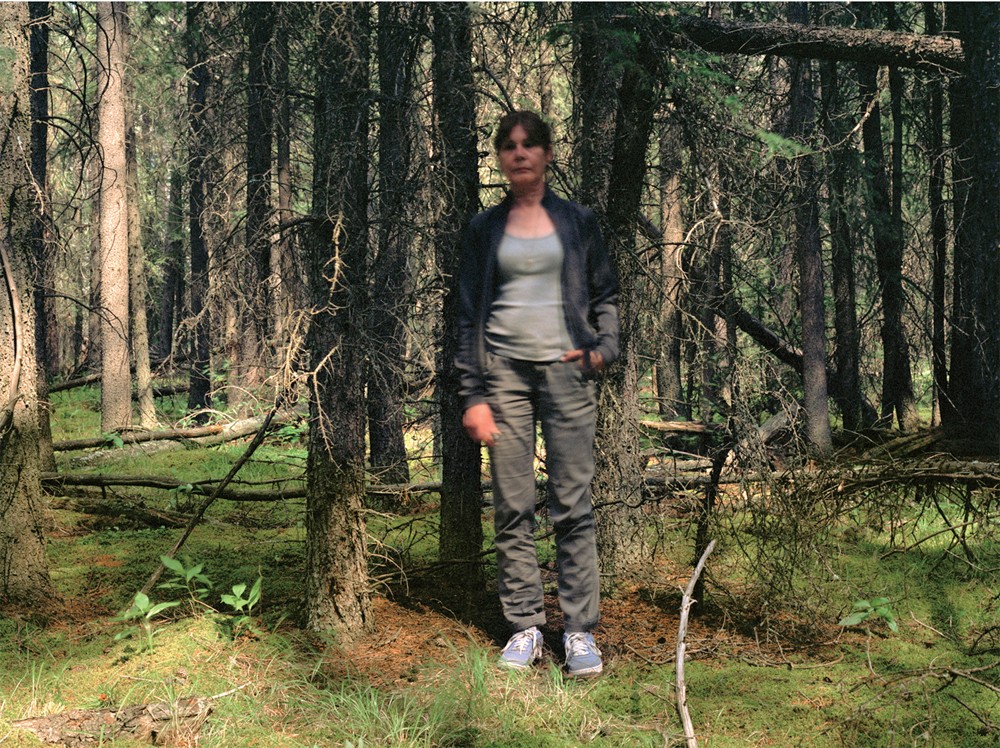
Extended Breathing in Dappled Light, 2009-2010, Fujitrans, lightbox, 45 x 65.” Courtesy Paul Petro Contemporary Art, Toronto.
Lake’s recent “Extended Breathing” contains some of her most beautiful and subtle work to date. Shot in various locations at night under artificial light and displayed in lightboxes, the pieces involved extended takes of Lake attempting, and invariably failing, to stand still and simply breathe for one hour. In Extended Breathing: While Highlights Travel, 2009, for example, Lake stands in front of an old stone building, her face completely ablur, lozenges of light sweeping across the ground behind her. Extended Breathing in Dappled Light, 2009, finds Lake in a forest, hand in her pocket, face blurred, light trickling down through trees that are in perfect focus. And in the strikingly beautiful Extended Breathing: Under Porchlight, 2009, Lake stands at the edge of a wooden porch in luridly bright light, her whole body a blur; above a fence is an arc of foliage and a patch of perfect twilight blue sky. Lake’s blurred figure in these photographs is the result of the long exposures and the impossibility of remaining still for that long, and her ghosting body against all that luminous, crystalline detail creates an immediate reversal of foreground and background. “While I’m standing there for one hour,” Lake told me, “I’m making the image in my mind’s eye, but what I’m thinking about is not predictable. Sometimes I’m in a meditative state, sometimes I’m responding to my body, sometimes to a memory.” “Extending Breathing” is a highly introspective series, her body, and time, now almost wholly subjective and in the process of disappearing.
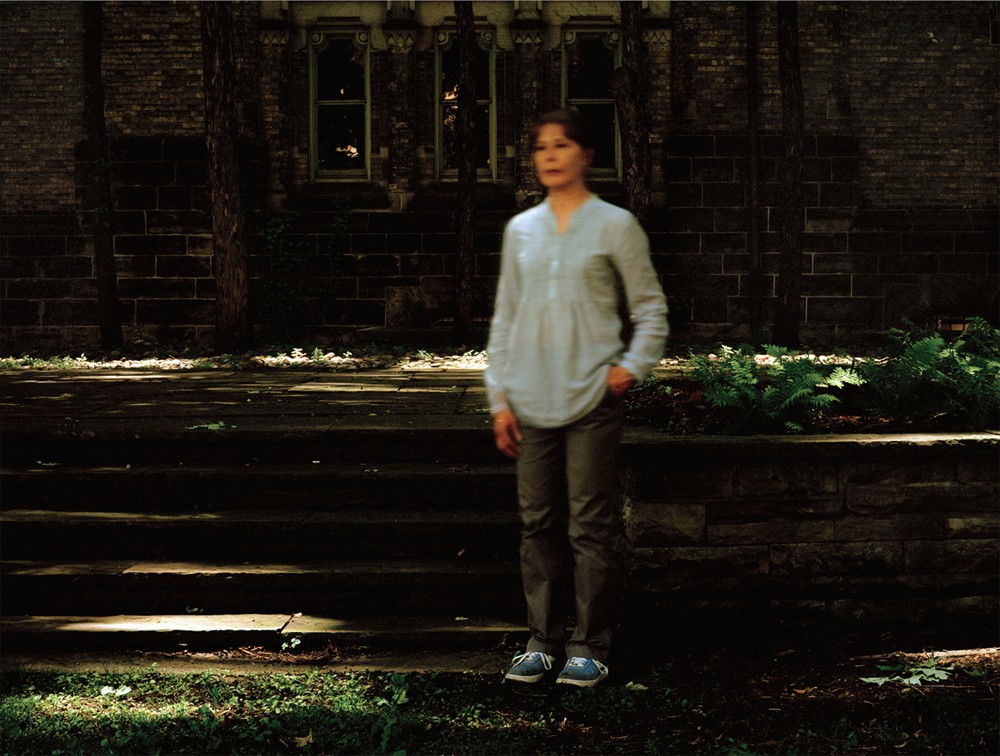
Extended Breathing While Highlights Travel, 2009-2010, Fujitrans, lightbox, 45 x 65.” Courtesy Paul Petro Contemporary Art, Toronto.
“Where do we begin to define our true selves?” Lake asks in the text from “On Stage.” Unlike portrait photography, which owes not a little of its aesthetic to the great portrait painters like Titian and Velázquez, with its striving to encapsulate an essence, the art of the photographic self-portrait is more often than not fraught, tentative, uncertain and experimental. Think, for example, of Lee Friedlander’s self-portraits as shadows on walls and urban sidewalks, or the dark, quizzical look on Diane Arbus’s face when she photographed herself pregnant and naked from the waist up, or Nan Goldin’s wounded and confused depictions of herself, or Robert Mapplethorpe’s smoldering self-portrait as a demon. Lake’s photographic works consist almost entirely of self-portraits, though they are not in any way documentary. They are, rather, experiments delimiting the boundaries of the body and the self from the world of society and history and, increasingly, from the natural world. As to how one begins to define one’s true self, I think the answer that falls from Lake’s work is that it neither begins nor ends but continues moment by moment, restless and blurring, to a vanishing point she has, fortunately for us, not yet reached. ❚
Daniel Baird is a Toronto-based writer on art, culture and ideas.
To order your copy of Issue #119, click here.

